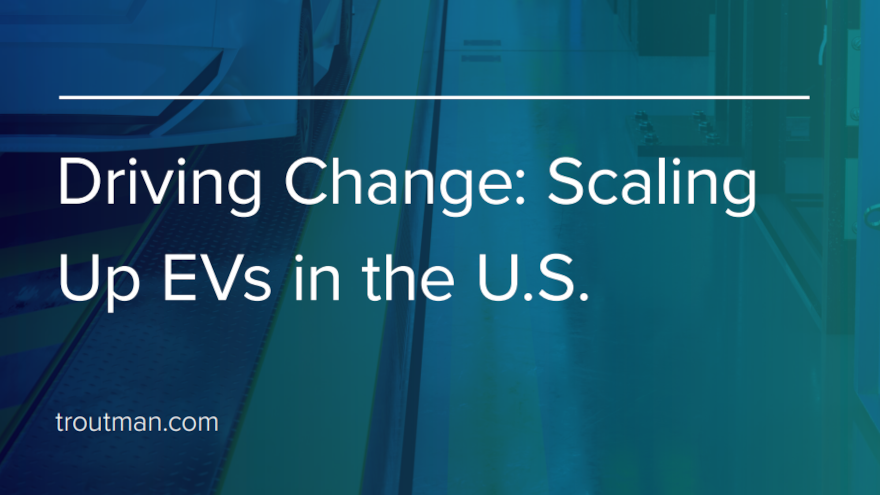Report: 4 ways to foster fundamental changes needed for EV scaling

Screenshot courtesy of Troutman Pepper.
Electric-vehicle naysayers likely harp on challenges such as outdated and insufficient infrastructure, alongside environmental regulatory programs, as hurdles to continued expansion of EVs and battery manufacturing in the U.S.
U.S. law firm Troutman Pepper acknowledged those elements and other risks undermining EV adoption in its new industry report released on Monday. But Troutman Pepper also offered four recommendations to help.
In Driving Change: Scaling up EVs in the U.S., Troutman Pepper has been joined by a variety of market experts to reflect on recent growth in the sector and the impediments to continuing this expansion.
Experts explained that federal incentives, growing consumer demand and supportive policies are driving efforts by the automotive industry to scale up production and uptake of electric vehicles.
Troutman Pepper pointed out consumer demand has led to a record number of EVs on the road. And the firm said businesses, consumers, and policymakers are increasingly aligning their efforts to support that growth.
However, Troutman Pepper acknowledged that scaling further requires transformative change to infrastructure and environmental regulatory programs — as one report participant put it, “everything has to change.”
The report argued that the continued advancement of EVs requires a fundamental and dynamic upgrade and expansion of charging station infrastructure, along with a supportive regulatory framework for the establishment of new manufacturing facilities in the U.S. to produce EV batteries and vehicles.
Although the federal government has offered significant incentives to accelerate production, Troutman Pepper pointed out that automakers have been left scrambling to unpick complex infrastructure permitting rules.
Experts added this is further complicated by individual interpretations and implementation by states of federal policies and guidelines.
“While the federal government is pushing out new policies and regulatory guidance to aid in the permitting of battery manufacturing, it is the states that implement those programs,” said Andrea Wortzel, Troutman Pepper’s environmental and natural resources practice group leader.
“Some states are more cautious than others, and the application of environmental regulatory programs to the various aspects of EV battery manufacturing can vary significantly from state to state,” Wortzel continued in a news release.
Additionally, the report highlighted the urgent need for faster permitting for scaled up battery manufacturing facilities. The report also touched on concerns around the workforce skills, technology, machinery and raw materials necessary to support the desired growth in this industry.
“A lot needs to happen for EVs by 2026 to be widely adopted,” Troutman Pepper Partner Dan Anziska said in the news release. “That includes speeding up the permitting process for battery gigafactories and speeding up manufacturing facilities.
“It is expensive and time-consuming to build a massive gigafactory, as well as being reliant on many suppliers, and there are so many that have been announced. There’s competition for everything from labor to equipment and resources,” Anaziska continued.
Having spoken with EV industry experts who shared their insights about the biggest infrastructure and regulatory challenges facing the industry, the report focused on the following four recommendations:
Continue to expand the public charging station network.
Troutman Pepper found that states must clarify the charging station functions that should be performed by electric utilities. In states encouraging non-utility firms to own and operate charging stations, regulators must confirm that operators will not be required to be permitted as public utilities, but be viewed instead as service providers operating in a competitive environment.
Provide clarity on environmental rules for battery factories.
The firm pointed out automotive companies and battery makers are driving innovation. However, a lack of regulatory clarity can delay permits and investments in new battery plants in the U.S.
Troutman Pepper encouraged policymakers to seek and deliver clarity, particularly related to the import or manufacture of chemical components for EV batteries, as well as recycling processes. Experts said these rules will help advance innovation in the manufacturing, recycling, and management of battery waste.
Streamlined approval processes for key battery chemicals.
Troutman Pepper suggested the EPA should streamline approvals for chemicals used in EV battery production that are similar to ones already approved. Applicants may not have access to all available information due to trade secret protections.
“But the EPA does and could use it to make more informed and streamlined decisions,” the firm said.
Similarly, Troutman Pepper suggested the EPA could issue additional policies or guidance to outline how wastewater from EV battery production is handled under the 1986 categorical pretreatment standard for battery manufacturing. Minimally, the EPA could outline the information and process for determining whether the standards apply to the technology used in EV battery manufacturing.
Encourage innovation and collaboration in battery recycling and disposal.
Troutman Pepper determined the industry would benefit from collaboration regarding best management practices associated with EV battery recycling, including management of shredding operations. This includes the development of uniform, certain, and protective environmental permitting programs for EV battery recycling.
Troutman Pepper said that addressing these bottlenecks is essential for the expansion of EV adoption, and the report metioned additional proposals from the firm’s environmental and energy teams on how this can happen.
“Momentum is building for the transition to electric and there is a tremendous push to supercharge EV sales. The report concludes that the right mixture of public policy, investment, and innovation will enable the EV sector to achieve its full potential,” Troutman Pepper said.
Driving Change: Scaling Up EVs in the U.S. can be downloaded via this website.


